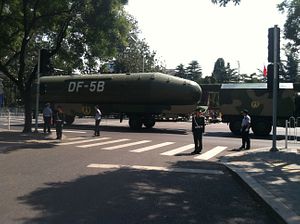Are there areas in which China, the United States, and Russia can manage competition through arms control? The question is more than just theoretical; the Trump administration seems serious about threatening both Russia and China with economic and military tools if they do not come to the table, to the extent of withdrawing from the Open Skies treaty and threatening to withdraw from New START. Although many of the more recent major arms control treaties have been primarily bilateral in nature, the Pacific has a history of successful multilateral arms limitation in the form of the Washington Naval Treaty and its successors. Moreover, some of the nuclear-era treaties (including Open Skies and the Nuclear Non-Proliferation Treaty) have multilateral aspects.
A report from the Institute for Peace Research and Security Policy details some of the ways in which the three great powers could benefit from arms control, and how they might approach planning for such an eventuality. As the authors point out, there are several areas in which the three powers could benefit from arms control. China has substantial advantages in intermediate-range missiles (both cruise and ballistic) especially on the ground. Russia and the United States have nuclear stockpiles that vastly exceed the highest estimates of China’s arsenal, or of any available Chinese plans. At the same time, China does not offer anything approaching the same level of transparency as Russia or the United States regarding its own nuclear arsenal, in part because of concerns that doing so would enable a successful first strike. U.S. missile defense systems are considerably more advanced than those of Russia and China, and in any case threaten to destabilize the nuclear deterrent relationship. More broadly, the expansion of Chinese conventional naval forces might at some point call for cooperation on shipbuilding limits. While Russia and China currently have a good relationship, Beijing has a much higher defense budget ceiling that Moscow, meaning that mutual restraint would probably be of some benefit to Russia.
There’s nothing at all wrong with trying to cooperate on specific issues in context of broader competition. We can imagine a series of interlocking agreements that would benefit all three countries by limiting expansion of intermediate-range missile arsenals, limiting the extent of China’s nuclear growth while also producing great transparency, and limiting the sophistication and extent of U.S. missile defense systems. Asymmetric treaties, which place different obligations upon different members, are complicated but can work. Under the Washington Naval Treaty, for example, Japan accepted numerical inferiority to Great Britain and the United States in return for concessions on the fortification of bases in the Pacific.
“Imaginable,” however, does not mean “likely.” And it certainly does not mean that the United States can succeed by undertaking clumsy efforts at compellance. My next two columns examine the obstacles to successful multilateral arms control, and especially the downsides of the Trump administration’s approach.

































